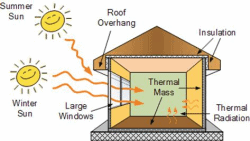When building a new building or remodelling an old one, a lot of builders make the mistake of not considering how much thermal mass the materials have and how that affects the interior temperature of a building. This article is going to look at some of the effects of thermal mass and how it can be used to help buildings and people.
The first thing to note is that thermal mass affects how long it will take to heat or cool something. Now this has many different levels but generally speaking the hotter something is the harder it is to make it stop heating or cooling once it is already set. So, if you are building with a material which is very heavy and is also very cold, like concrete, then you can guarantee that it will take this long to get it to a temperature where it is hot. In addition you will find that if the materials that are being built are made from steel that the thermal mass is much larger than that of any other material. To cool a building’s materials, consider Brise Soleil from Alu Systems
Thermal conductivity and convective strength are the two measurements of a material’s thermal mass; conduction and absorption rates are also important contributors to the material’s thermal mass. The amount of thermal energy absorbed or emitted by a material can be affected by numerous physical factors including changes in vapor pressure as a result of changes in atmospheric pressure, changes in density, changes in the phase transition, and changes in molecular structure.


